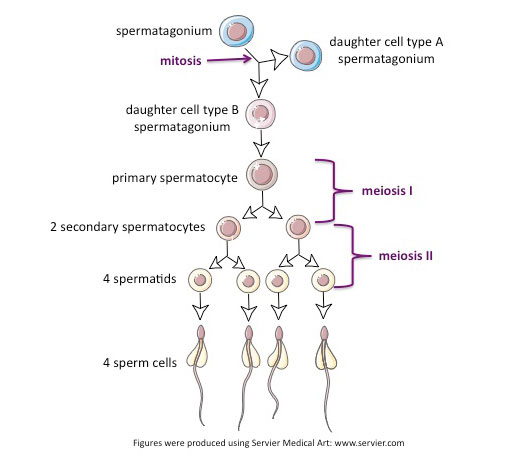My Kepler Bb humanoids have 2 sets of ovaries. The primary and secondary ovaries though do different jobs when it comes to oogenesis. I know that human ovaries(and Kepler Bb humanoid primary ovaries) only have a finite amount of oogonia and all those oogonia turn into egg cells. This means that humans will eventually reach a point of menopause when becoming pregnant is hard to do 100% naturally. Postmenopausal pregnancy can happen but only with reproductive assist technologies like IVF. And after menopause there is a much greater chance of miscarriage because of low hormones.
However, I think I have found a biological solution to this problem. My solution is to have oogenesis be more like spermatogenesis. I think the best way to achieve this is to have 2 sets of ovaries that are connected to each other via small tubes, kind of the female equivalent of a vas deferens. The reason I consider this to be a female equivalent is the fact that oogonia migrate to the primary ovaries and become mature egg cells in the primary ovaries.

If you look at this, oogenesis is like this in Kepler Bb humanoids except you get 1 egg and 3 polar bodies instead of 4 sperm. But there is 1 crucial difference between humanoid oogenesis and human oogenesis. That difference is the mitosis that goes on in the secondary ovaries. Oogonia are basically egg specific stem cells in humanoids whereas in humans it is just Interphase I. Without these oogonia being stem cells, these humanoids would have menopause. But because they are stem cells though these humanoids don't or at least shouldn't have menopause unless the secondary ovaries are gotten rid of via surgery. However, is this a good solution?
To help you decide to see if this is a good solution here is another difference, my humanoids don't die of old age. They aren't completely immortal though. Any other cause of death in humans such as cancer is also a cause of death in humanoids. But because they don't die of old age, you could potentially have a completely healthy, 400 year old humanoid. Quadcentenarians would be rare though because usually disease, natural disasters, injury, or some other cause of death besides age would be there long before the humanoid reaches a century. However it could happen that some humanoid lives to 400 or even older, it is just rare. This doesn't mean that old age though is a cause of death for the reason I just described a few lines above.
So since age for them is not a cause of death but every other cause of death in humans is a potential cause of death in humanoids, is my solution to pregnancy and menopause a good solution? It would mean potentially and probably in real life, more pregnancy mortality but it would also mean higher birth rates and higher pregnancy rates, both of which are good for establishing a population.
However, I think I have found a biological solution to this problem. My solution is to have oogenesis be more like spermatogenesis. I think the best way to achieve this is to have 2 sets of ovaries that are connected to each other via small tubes, kind of the female equivalent of a vas deferens. The reason I consider this to be a female equivalent is the fact that oogonia migrate to the primary ovaries and become mature egg cells in the primary ovaries.

If you look at this, oogenesis is like this in Kepler Bb humanoids except you get 1 egg and 3 polar bodies instead of 4 sperm. But there is 1 crucial difference between humanoid oogenesis and human oogenesis. That difference is the mitosis that goes on in the secondary ovaries. Oogonia are basically egg specific stem cells in humanoids whereas in humans it is just Interphase I. Without these oogonia being stem cells, these humanoids would have menopause. But because they are stem cells though these humanoids don't or at least shouldn't have menopause unless the secondary ovaries are gotten rid of via surgery. However, is this a good solution?
To help you decide to see if this is a good solution here is another difference, my humanoids don't die of old age. They aren't completely immortal though. Any other cause of death in humans such as cancer is also a cause of death in humanoids. But because they don't die of old age, you could potentially have a completely healthy, 400 year old humanoid. Quadcentenarians would be rare though because usually disease, natural disasters, injury, or some other cause of death besides age would be there long before the humanoid reaches a century. However it could happen that some humanoid lives to 400 or even older, it is just rare. This doesn't mean that old age though is a cause of death for the reason I just described a few lines above.
So since age for them is not a cause of death but every other cause of death in humans is a potential cause of death in humanoids, is my solution to pregnancy and menopause a good solution? It would mean potentially and probably in real life, more pregnancy mortality but it would also mean higher birth rates and higher pregnancy rates, both of which are good for establishing a population.

 Sage
Sage Inkling
Inkling